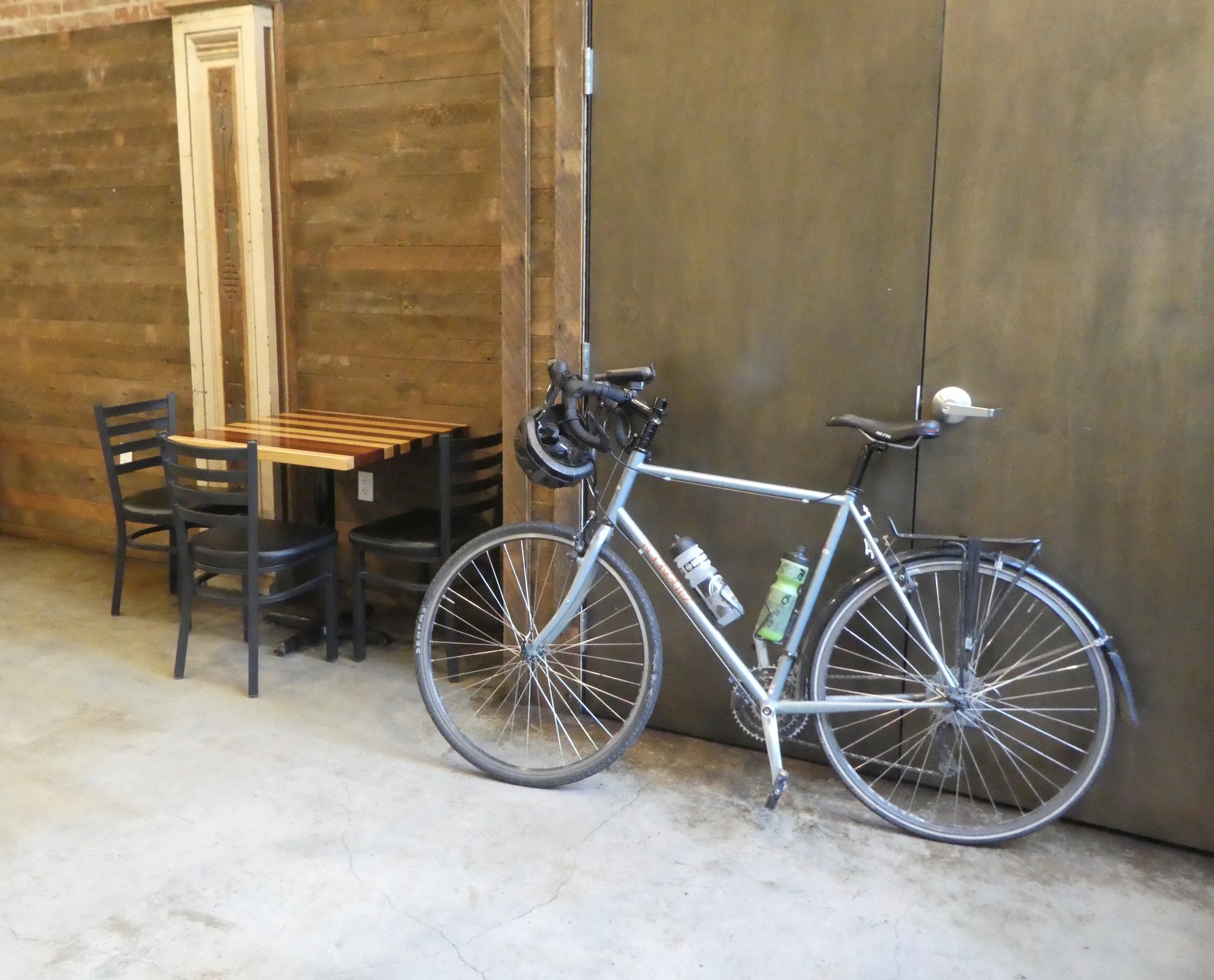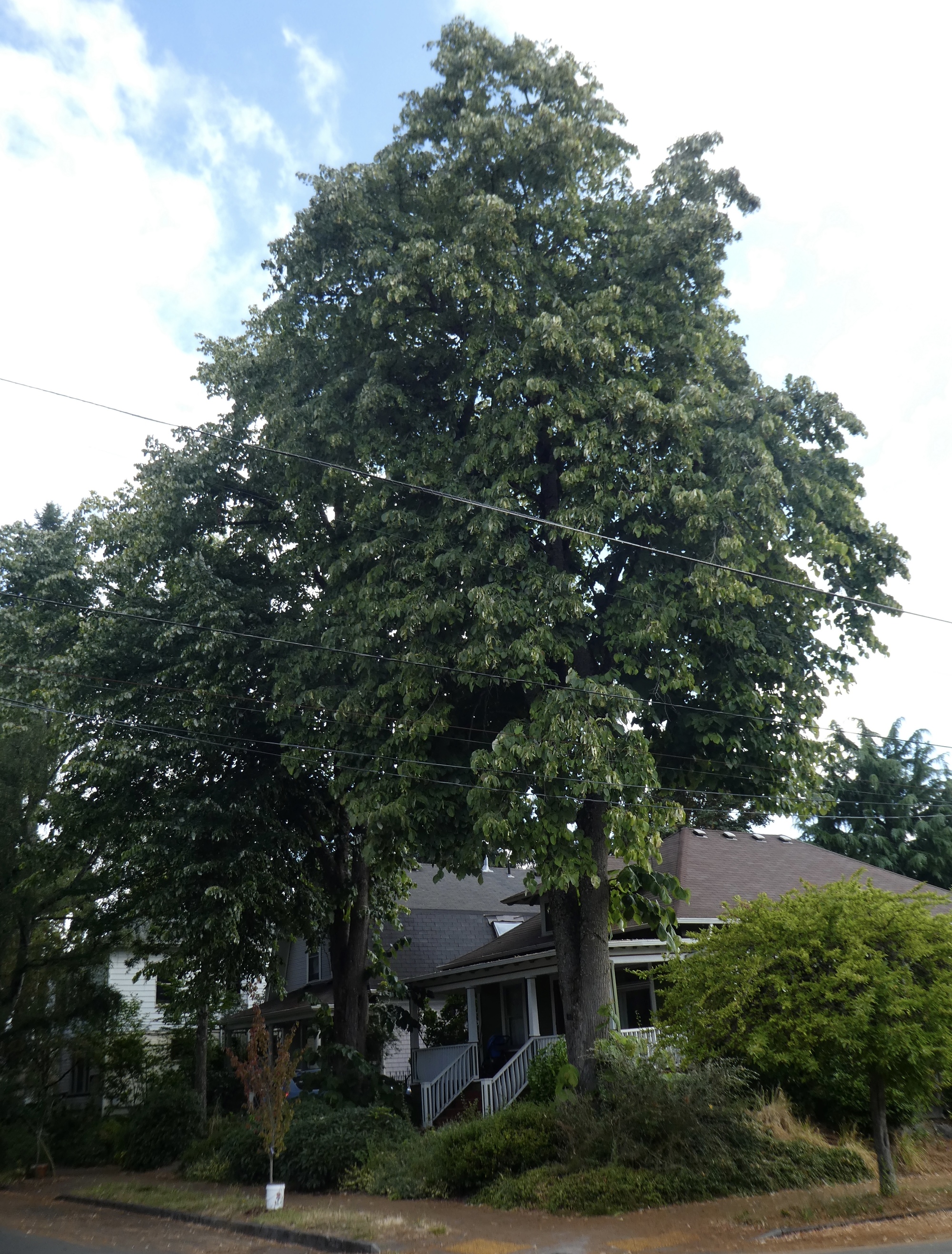August 7, 2020
The Portland Heritage Tree Quest, Group 16
I get an uncharacteristically early start this morning, leaving the apartment before seven on my way downtown to Caffe Umbria, as far as I know one of the few coffee shops in town offering indoor seating at present. It’s cool today - much cooler than it’s been for the past few days - and very pleasant as I bike west down Lincoln Street and across the Hawthorne Bridge. Rachael and I are really pleased with where we’re staying this time, in a comfortable basement apartment about three miles east of the Willamette. A lot of what makes it so attractive to us is this ride along Lincoln Avenue, one of Portland’s finer bike boulevards.
I don’t make it to Caffe Umbria though. After biking across the bridge I head north along Naito Parkway, admiring the flourishing gallery of wall art that is new since we left town. I cross the street to photograph a particularly appealing mural, and only then notice that I’m right next to Café Ponté, one of my favorite little coffee shops in town. It’s a place I first discovered last year when we were staying at a riverfront condo, and it was in easy walking distance.
I see it’s open, and appears to offer indoor seating. I crack the door and ask Kiara (the same server that’s been here since I first started showing up) if I can come in. Yes, and I can bring Rodriguez with me, since there’s plenty of room with so many tables removed now. Perfect. I wouldn’t stay otherwise, because I wouldn’t trust leaving the bike outside in this neighborhood.

| Heart | 1 | Comment | 0 | Link |

| Heart | 1 | Comment | 0 | Link |

| Heart | 1 | Comment | 0 | Link |

| Heart | 1 | Comment | 0 | Link |
A couple of hours later I finally finish the news, get caught up on the blog, and head off to find some big trees. I’ve got a short list today - just seven trees, all in the southeast - so that I can save a few for a final outing next week.
The first several are in the Sellwood District. For the first time since we returned to Portland, I cross the river over Tilikum Crossing and enjoy riding south along the Springwater Corridor. Traffic is light this morning, and when passing the occasional biker I flip my bandana up across my face - a movement that’s becoming natural and almost automatic now.

| Heart | 4 | Comment | 0 | Link |

| Heart | 3 | Comment | 0 | Link |

| Heart | 1 | Comment | 0 | Link |

| Heart | 2 | Comment | 0 | Link |

| Heart | 2 | Comment | 0 | Link |

| Heart | 3 | Comment | 0 | Link |

| Heart | 1 | Comment | 0 | Link |

| Heart | 2 | Comment | 0 | Link |
From Sellwood I turn east, back on the Springwater Corridor again. Coming to the edge of the Eastmoreland District, I leave the corridor and climb up a short, ridiculously steep connector to Crystal Springs. I’m happy to be able to get into a gear low enough so I can make it up without dismounting - both of our bikes are really getting into poor shape and badly need a trip to the bike doctor, but that’s a servicing that will need to wait for this winter. We’re both staying to generally flat, easy rides until we lock these guys up in our bike locker for the next 3-5 months and leave for Croatia.
The rest of the ride goes generally without incident, but there are a few things worth noting. When staring up at my giant Norway Maple, I see a woman and her two young children walking my way on the sidewalk. She looks uncertain about me and steers the kids out into the street - who is this masked man in our neighborhood, looking up at the trees? As they pass I smile and explain myself, and we chat a bit. They love this tree too, especially the young boy - he tells me he likes to climb on its roots.
Later, I’m on the edge of Eastmoreland Golf Course, peering across the fence and wondering if I can see its Dove Tree from the road. Nope. There is a maintenance road and an open gate though, so I bike down it going in the direction the tree is marked on the map. A hundred yards later a guy wheels up in a maintenance cart and instructs me to turn back. I do of course, but I tell him why I’m there. He knows about this tree, but says it’s on them island’, which is currently closed to the public. So not now, but maybe someday?

| Heart | 3 | Comment | 0 | Link |

| Heart | 2 | Comment | 0 | Link |

| Heart | 2 | Comment | 0 | Link |

| Heart | 1 | Comment | 0 | Link |

| Heart | 2 | Comment | 0 | Link |

| Heart | 1 | Comment | 0 | Link |

| Heart | 1 | Comment | 0 | Link |

| Heart | 1 | Comment | 0 | Link |

| Heart | 1 | Comment | 0 | Link |

| Heart | 1 | Comment | 0 | Link |

| Heart | 1 | Comment | 0 | Link |
Keeping score
Group 1 (7 species): grand fir, willow oak, hedge maple, Douglas fir, incense cedar, tulip tree, sugar maple.
Group 2 (9 species): silver maple, Japanese cedar, oriental plane tree, European beech, American chestnut, copper beech, mockernut hickory, basswood, butternut.
Group 3 (9 species): ginkgo, crape maple, northern red oak, deodar cedar, bigleaf linden, giant sequoia, coast redwood, Japanese pagoda tree, Mount Fuji flowering cherry.
Group 4 (8 species): Zelkova, Carolina poplar, Japanese red pine, Katsura, bur oak, river birch, catalpa, wych elm.
Group 5 (8 species): Monkey puzzle tree, western white pine, boulevard cypress, madrone, single needle pinyon, pecan, Coulter pine, Monterey pine.
Group 5-1/4 (2 species): Port Orford cedar, English yew
Group 6 (6 species): White fir, Atlas cedar, Cedar of Lebanon, Endlicher pine, Dawn redwood, Umbrella pine.
Group 7 (6 species): China Fir, Blue Atlas Cedar, Eastern White Pine, Ponderosa Pine, Sitka Spruce, Yellow Bellflower Apple.
Group 8 (5 species): Himalayan Pine, Gray Pine, Apache Pine, Italian Stone Pine, Loblolly Pine
Group 9 (6 species): Sycamore Maple, Japanese Larch, Spanish Chestnut, Weeping Willow, Oregon White Oak, Oregon Myrtle.
Group 9.5 (4 species): Southern Magnolia, Empress Tree, Saucer Magnolia, Yoshino Cherry.
Group 10 (4 species): Apricot, Weeping Cherry, Rhododendron, Gravenstein Apple.
Group 11 (10 species): Common Horse Chestnut, English Walnut, European Hornbeam, American Persimmon, Silver Linden, Sasafrass, Southern Catalpa, Bigleaf Maple, Pacific Dogwood, California Buckeye.
Group 12 (7 species): English Elm, London Plane Tree, Scarlet Oak, Chestnut Oak, Caucasian Wingnut, Smooth-leaf Elm, American Sycamore.
Group 12, continued (4 species): American sweetgum, Judas tree, Canyon live oak, European white elm.
Group 13 (9 species): Black walnut, Pin oak, American elm, Cucumber tree (?), Duch elm, Ohio buckeye, Shellbark hickory, Oregon ash, Weeping beech.
Group 14 (7 species): Japanese maple, Lavelle Hawthorn, Mountain silverbell, Persian ironwood, Cryptomeria, Bald cypress, Lacebark Pine.
Group 15 (5 species): Camperdown Elm, Bigleaf Linden, Tartan Elm, American Hop-Hornbeam, American Ash.
Group 16 (6 species): Black Tupelo, Basswood, Yellowwood, Norway Maple, American Hornbeam, Yellow buckeye.
Dropped (2 species): Paradox Walnut, which I couldn’t find and may no longer exist; and the Dove Tree, buried in an inaccessible location in the Eastmoreland Golf Course.
| Rate this entry's writing | Heart | 3 |
| Comment on this entry | Comment | 4 |
Not a bad way to start the day.
On a somewhat unrelated note, have you seen any of the orange Biketown bikes or the shared scooters out and about? I've been wondering if those services are Covid survivors.
4 years ago
4 years ago
4 years ago
I wonder what will happen to that part of the fleet when Lyft takes over. Probably not much use on Nike campus with all the empty offices.
Ebikes will be a great addition to the program. Hopefully they add instructions to be sure to bring hand sanitizer.
Interesting that the scooters aren't out as much.
4 years ago

